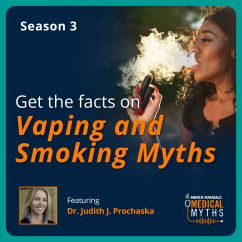Vaping refers to inhaling vapor (volatilized liquid) produced by battery-powered devices. The vapor can contain nicotine, tetrahydrocannabinol (THC) and cannabinoid (CBD) oils, and other substances, flavorings, and additives. Although the liquid ingredients are volatilized by heating, there is no combustion involved; the apparent "smoke" that results is water vapor.Vaping refers to inhaling vapor (volatilized liquid) produced by battery-powered devices. The vapor can contain nicotine, tetrahydrocannabinol (THC) and cannabinoid (CBD) oils, and other substances, flavorings, and additives. Although the liquid ingredients are volatilized by heating, there is no combustion involved; the apparent "smoke" that results is water vapor.
Ingredients
In electronic cigarettes (e-cigarettes), the active substance is liquid nicotine; no other tobacco products are present. Electronic cigarettes and vaporizers were initially marketed as a device to help people quit smoking tobacco, but e-cigarette users remain addicted to nicotine. E-cigarettes have not received U.S. Food and Drug Administration (FDA) approval as smoking cessation devices. In electronic cigarettes (e-cigarettes), the active substance is liquid nicotine; no other tobacco products are present. Electronic cigarettes and vaporizers were initially marketed as a device to help people quit smoking tobacco, but e-cigarette users remain addicted to nicotine. E-cigarettes have not received U.S. Food and Drug Administration (FDA) approval as smoking cessation devices.
Some people use the vaporizers to inhale active ingredients other than nicotine, including the active ingredients of Some people use the vaporizers to inhale active ingredients other than nicotine, including the active ingredients ofmarijuana, hashish oils, synthetic marijuana (THC for all three), and amphetamines.
In addition to water and the active ingredient, commercially produced vaping liquids usually contain propylene glycol or vegetable glycerin-based liquid along with flavoring and other chemicals, including trace amounts of metals. Illicitly produced vaping agents likely contain additional inactive ingredients, some of which, such as vitamin E acetate, may be involved in vaping-related lung injury.In addition to water and the active ingredient, commercially produced vaping liquids usually contain propylene glycol or vegetable glycerin-based liquid along with flavoring and other chemicals, including trace amounts of metals. Illicitly produced vaping agents likely contain additional inactive ingredients, some of which, such as vitamin E acetate, may be involved in vaping-related lung injury.
Complications of Vaping
Potential complications of vaping include
Use of nicotine by nonsmokers, leading to nicotine addictionUse of nicotine by nonsmokers, leading to nicotine addiction
Severe lung injury
One concern is that nonsmokers, particularly adolescents, who inhale nicotine, become addicted.One concern is that nonsmokers, particularly adolescents, who inhale nicotine, become addicted.
Certain substances in the vapor appear to lead to severe lung injury and sometimes death. The Centers for Disease Control and Prevention (CDC) the FDA, and other clinical and public health partners are investigating a national outbreak of vaping-related lung injury. (See CDC: Outbreak of Lung Injury Associated with the Use of E-Cigarette, or Vaping, Products.)
THC-containing vaping products and those with vitamin E acetate are linked to cases of severe lung injury related to vaping. The CDC and FDA recommend that people not use THC-containing e-cigarette, or vaping, products, particularly from informal sources like friends, family, or in-person or online dealers. Vitamin E acetate should not be added to any e-cigarette, or vaping, products. THC-containing vaping products and those with vitamin E acetate are linked to cases of severe lung injury related to vaping. The CDC and FDA recommend that people not use THC-containing e-cigarette, or vaping, products, particularly from informal sources like friends, family, or in-person or online dealers. Vitamin E acetate should not be added to any e-cigarette, or vaping, products.
More Information
The following English-language resources may be useful. Please note that THE MANUAL is not responsible for the content of these resources.
Centers for Disease Control and Prevention (CDC): Outbreak of Lung Injury Associated with the Use of E-Cigarette, or Vaping, Products: Resources for healthcare providers and health departments gleaned from monitoring e-cigarette, or vaping, product use-associated lung injury (EVALI).
National Institute on Drug Abuse (NIDA): Vaping-specific information from the federal agency that supports scientific research into the drug's use and its consequences.
Drugs Mentioned In This Article




